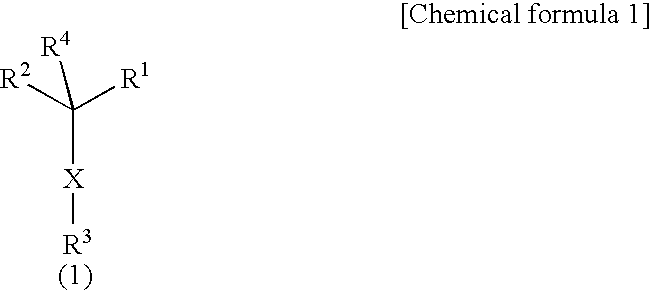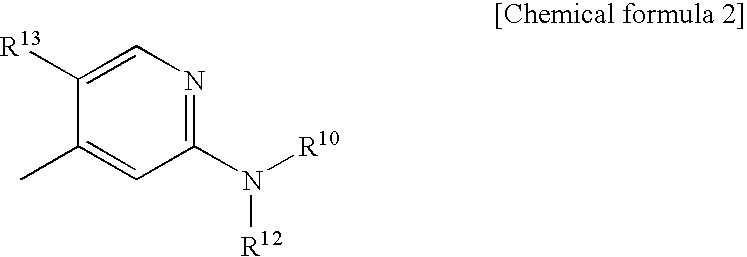Morpholine derivatives
- Summary
- Abstract
- Description
- Claims
- Application Information
AI Technical Summary
Benefits of technology
Problems solved by technology
Method used
Image
Examples
referential example 1
2-[(4-Chlorophenyl)sulfonylmethyl]-1,4-difluorobenzene
[0105]
Process 1:
[0106] 1) At 0° C., 4-chlorobenzenethiol (5.45 g, 38.2 mmol), triphenylphosphine (11.1 g, 41.6 mmol) and diisopropyl azodicarboxylate (8.16 ml, 41.6 mmol) were sequentially added to a tetrahydrofuran (150 ml) solution of 2,5-difluorobenzyl alcohol (5.00 g, 34.7 mmol). The reaction mixture was stirred at room temperature for 4 days, followed by concentration. The residue thus obtained was purified by silica gel column chromatography (1% ethyl acetate-hexane) to give 2-[(4-chlorophenyl)thiomethyl]-1,4-difluorobenzene (2.68 g, 29%) as a colorless oil.
[0107]1H-NMR(400 MHz,CDCl3)δ: 4.04(2H,s), 6.85-7.00(3H,m), 7.23(4H,s).
[0108] 2) After addition of 3-chloroperbenzoic acid (225 mg, 1.30 mmol) to a methylene chloride (5 ml) solution of 2-[(4-chlorophenyl)thiomethyl]-1,4-difluorobenzene (271 mg, 1.00 mmol) at 0° C., the resulting mixture was stirred at room temperature for 15 hours. The reaction mixture was diluted w...
referential example 2
4-(4-Chlorophenylsulfonylmethyl)pyridine
[0114]
[0115] A 1-propanol (50 ml) solution of 4-chloromethylpyridine hydrochloride (1.26 g, 7.65 mmol), sodium 4-chlorobenzenesulfinate (1.52 g, 7.65 mmol) and potassium acetate (1.50 g, 15.3 mmol) was stirred under heating at 70° C. for 8 hours. The reaction mixture was cooled to room temperature and then concentrated under reduced pressure. The residue thus obtained was caused to pass through a short column (silica gel, ethyl acetate) and the eluate was concentrated under reduced pressure. The residue thus obtained was subjected to silica gel column chromatography, and the fraction obtained from the hexane:ethyl acetate (=2:3) eluate was concentrated under reduced pressure to give the title compound (1.26 g, 62%) as a white solid.
[0116]1H-NMR(400 MHz,CDCl3)δ: 4.29(2H,s), 7.06(2H,d,J=6.1 Hz), 7.47(2H,d,J=8.8 Hz), 7.59(2H,d,J=8.5 Hz), 8.57(2H,d,J=6.1 Hz).
[0117] MS(m / z): 268(M++H)
referential example 3
2-[(2,5-Difluorophenyl)-hydroxymethyl]pyridine
[0118]
[0119] A hexane solution (1.53M, 3.92 ml, 0.6 mmol) of n-butyl lithium was added dropwise to a tetrahydrofuran (10 ml) solution of 2-bromopyridine (572 μl, 6 mmol) under an argon atmosphere at −78° C., followed by stirring for 30 minutes. To the resulting brown solution was added dropwise 2,5-difluorobenzaldehyde (655 μl, 6 mmol) and the temperature of the reaction mixture was gradually raised to room temperature. To the reaction mixture was added water. The resulting mixture was then extracted with ethyl acetate. After the solvent was dried, the residue obtained by concentration under reduced pressure was purified by purification by silica gel chromatography to give the title compound (120 mg, 9%) as a white solid.
[0120]1H-NMR(400 MHz,CDCl3)δ: 5.45(1H,br), 6.08(1H,s), 6.87-7.15(3H,m), 7.2-7.3(2H,m), 7.65(1H,m), 8.56(1H,m).
[0121] mp: 65 to 66° C.
PUM
 Login to View More
Login to View More Abstract
Description
Claims
Application Information
 Login to View More
Login to View More - R&D
- Intellectual Property
- Life Sciences
- Materials
- Tech Scout
- Unparalleled Data Quality
- Higher Quality Content
- 60% Fewer Hallucinations
Browse by: Latest US Patents, China's latest patents, Technical Efficacy Thesaurus, Application Domain, Technology Topic, Popular Technical Reports.
© 2025 PatSnap. All rights reserved.Legal|Privacy policy|Modern Slavery Act Transparency Statement|Sitemap|About US| Contact US: help@patsnap.com



